Smoke devices for the T-35 tank
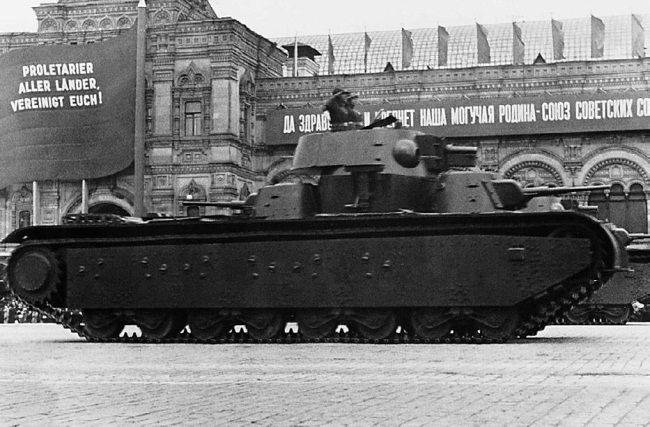
T-35 on Red Square. Photo Military.wikireading.ru
In 1932, Soviet industry developed and launched a series of tank smoke device TDP-3. This device could be installed on various platforms and solved the problems of infection, degassing and setting smoke screens. Tanks of different models became the carriers of the devices, including heavy T-35. However, in his case, it was not possible to manage only with a serial product, which led to the start of a new interesting project.
Standard equipment
The TDP-3 smoke device appeared almost simultaneously with the start of serial production of T-35 tanks. As a result, all new machines received such equipment, which gave them new opportunities. With the help of the TDP-3 device, the tank could put a smoke screen, covering itself or friendly troops. At that time it was believed that the equipment of a chimney was necessary for most tanks of all classes.
For installation on the T-35, the smoke device had to be slightly modified in terms of the layout of the units. On the sides of the turret box of the tank there were two armored boxes, in which two tanks of the TDP-3 were placed - 40 l each. Next to them were means of creating pressure to eject the liquid.
Fluid from pressure tanks was supplied to pipelines laid under the fenders. The tube passed through the trailing edge of the shelf and ended with a nozzle. Aerosol emission was carried out in the rear hemisphere.
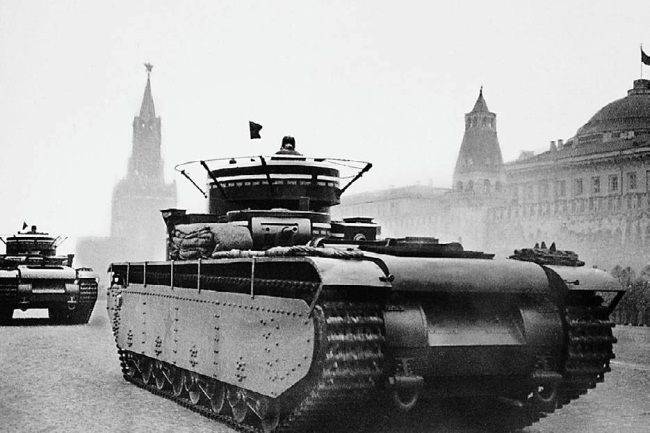
View of the stern. Small nozzles are visible on the edges of the fenders. Photo Military.wikireading.ru
To control the smoke in the fighting compartment provided hatches, giving access to the instruments. A simple remote control was placed inside the tank in the form of a sector with a lever, similar to that used in other projects with TDP-3 equipment. The crew could turn the device on and off, as well as control the intensity of the launch.
The installation of smoke screens was carried out using special S-IV fluid. 80 l of such a mixture provided a chimney for 5-12 minutes. Start was carried out both from a place and in motion, with one device or two. One tank could create a curtain hundreds of meters long and up to 25-30 m high. The use of toxic substances by T-35 tanks was not provided - unlike specialized chemical tanks with the same device.
Tank smoke device arr. 1932 quickly adapted to use on the T-35 and soon incorporated into its standard equipment. TDP-3 were mounted on all serial heavy tanks, giving them the required capabilities. Thanks to such devices, the tank unit could independently cover itself and protect against surveillance or shelling.
New requirements
The TDP-3 device met the original technical requirements, but was not without drawbacks. One of the main claims concerned the relatively small capacity of the tanks, which limited the duration of the chimney and the size of the resulting curtain. In addition, the tanks and pipelines did not have heating - this excluded the installation of the curtain in the cold season.
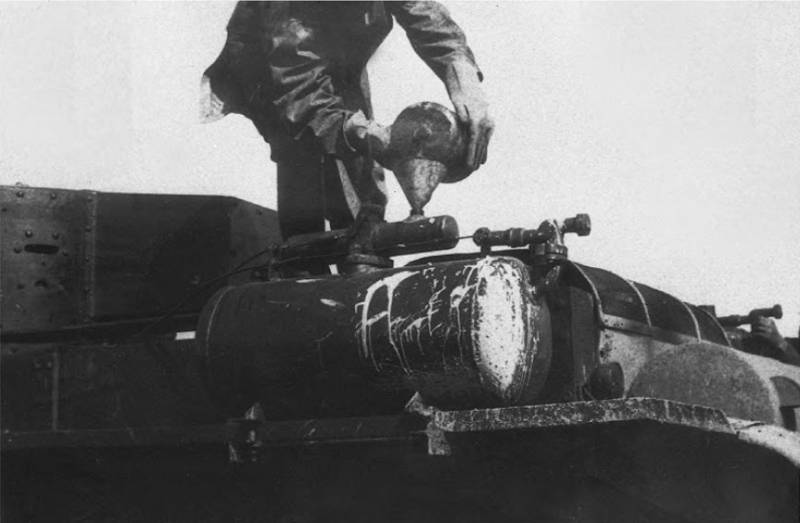
The TDP-3 device of an open installation on a BT series tank. Photo from the book Kolomyets M.V. "Light tanks BT." Flying tank "1930"
In 1936, all this led to the start of the development of a new tank smoke device specifically for the T-35. The new TDP-4 product was supposed to get rid of the drawbacks of its predecessor, and also more fully comply with the specific design of the heavy carrier tank. Due to the use of the TDP-4 device, the tank could turn into a full-fledged curtain designer, preserving all basic combat qualities.
The TDP-4 device was developed by the Kompressor plant, the main creator of chemical equipment for the army. Different army units were involved in the work. An experimental T-35 tank with new equipment was tested in the same 1936.
The main innovation of the project was enlarged tanks for special liquids. Cylinders of compressed gas were removed from the armored boxes near the turret box, which made it possible to free up space for tanks with a capacity of 90 liters. Cylinders for compressed air were transferred to the fighting compartment. They had a capacity of 5 l and kept the pressure of 150 kgf / sq.cm. Using pressure reducers, the pressure was reduced to 5 kgf / cmXNUMX, after which the compressed gas entered the liquid tanks.
Along the roof of the buildings, as before, there were pipelines for supplying fluid to the nozzles. However, this time they were laid next to the exhaust manifolds of the engine, which ensured the heating of both the pipe and the liquid in it. This allowed the use of smoke exhaust devices at any time of the year and in any weather conditions. The design of the nozzles as a whole has not changed.
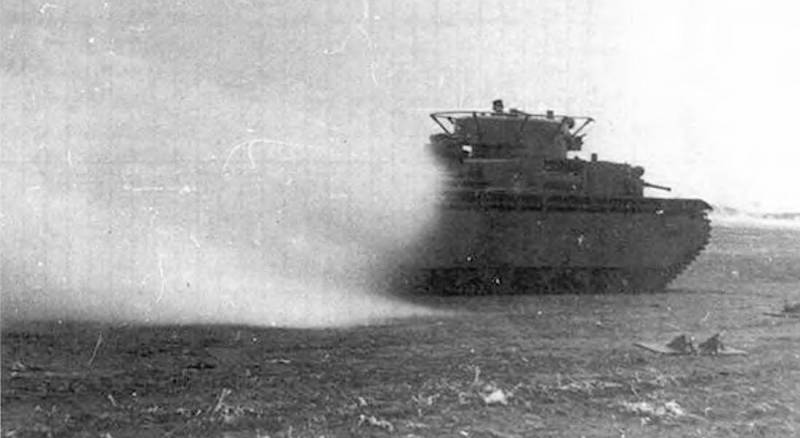
The T-35 performs a flue. Photo from the book Solyankin A. G., Pavlov M. V., Pavlov I. V., Zheltov I. G. "Domestic armored vehicles. XX century", Vol. 1
The increased capacity of the tanks gave obvious advantages. T-35 with TDP-4 could carry out the installation of the curtain for more time or with greater intensity. The maximum S-IV fluid flow rate reached 15 l / min. The tank could install a dense and invisible curtain with a height of up to 25-30 m and a length of 1600 m.
Return to original
In 1936, one of the T-35 production tanks lost the standard TDP-3 device, instead of which a new TDP-4 was installed. In this configuration, he was tested at the training ground and identified the strengths and weaknesses of the new development. The test results were unequivocal, but did not lead to a massive re-equipment of the equipment.
TDP-4 favorably with its predecessor, and the re-equipped T-35 had clear advantages over the serial. However, the new tank smoke device was not developed. The already built T-35 tanks retained the standard equipment of the previous model, and they were also installed on new-made vehicles. The reasons for this development are not clear, but some assumptions can be made.
In just a few years, the Compressor plant produced about 1500 TDP-3 devices. Such products were enough to equip new tanks of several types, including heavy T-35. The loss of a serial device according to its characteristics could be considered insignificant. Despite the limited time of the smoke and a smaller curtain, the TDP-3 coped with the tasks and provided proper camouflage.
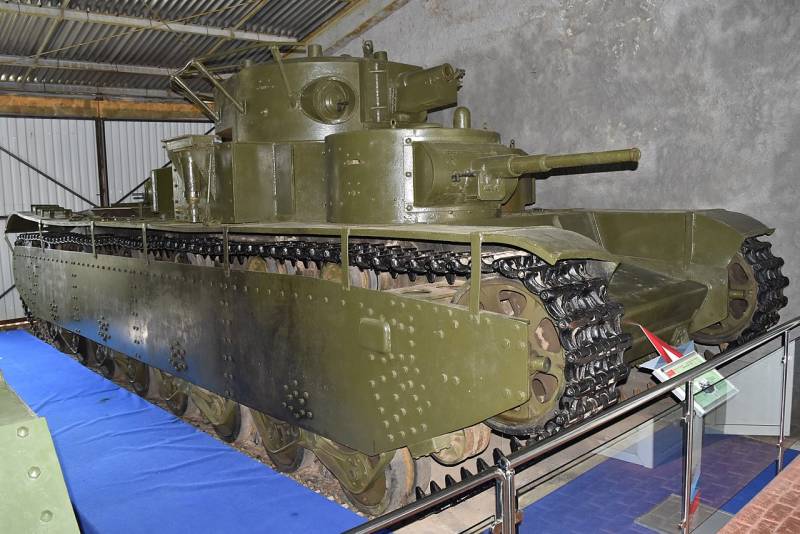
Museum T-35 in Kubinka. Smoke appliances are removed, only the windows under the nozzles remind of them. Wikimedia Commons Photos
With all its advantages, TDP-4 had a characteristic drawback in the form of large dimensions and mass. In this regard, he lost to the previous TDP-3 - and therefore was not compatible with all existing tanks. Without prejudice to mobility, only medium and heavy armored vehicles could carry it, which was supposed to lead to unification.
The specific ratio of the strengths and weaknesses of the device, as well as the features of the use of such devices, led to a logical ending. TDP-4 did not take into service and put in series. The troops remained the existing device of the previous model. However, not all tanks had such equipment. Some of the machines did not receive TDP-3 at all, while others removed such equipment during operation.
After failure with the new device, the TDP-3 retained the place of the main model of its class in the Red Army. It was actively used on various types of armored vehicles until the beginning of the forties. Later, with the outbreak of World War II, tanks with such equipment provided cover for troops and confirmed their capabilities. In practice, it was shown that even a limited amount of special fluid may be enough to solve the task and hide the troops from the enemy.
Information